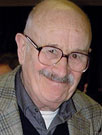Ignorance is bliss

Placements benefit all involved, as there is no better way of learning than teaching. Inexperienced minds can throw up welcome surprises, says David Bernstein
Educational or vocational? The eternal debate on the purpose of art teaching entered a new dimension with Emma Germain’s think-piece (DW 24 April). Her argument is summed up in the standfirst/ ‘Design education doesn’t end with graduation – to make it in the real world, placements and apprenticeships are a must.’
Could this mean a corrective swing of the pendulum towards education? Hilary French, head of the Royal College of Art’s architecture and design school, rightly says, ‘University must be about education first and training second.’ And, if the latter can be achieved by placements and apprenticeships, then there is hope that the breadth and depth of the education can be enhanced. As D&AD president Simon Waterfall says, speaking as a creative director, ‘I can teach them business skills.’
What our industry requires from a university-educated entrant is a trained mind – one likely to be ignited by the sort of challenges we face, and one that is broad, open, receptive and questioning. There should be accompanying evidence of creative skills across a wide field of endeavour, and an understanding of what to expect in the real world of work.
A good placement will hone those skills. It will reveal that world as a complex environment, where there are various tasks and a multiplicity of solutions. It’s a long way from what student Tim Greatrex calls ‘the isolated world of study’.
Placements engender serendipity. They encourage students to encounter different kinds of people and practical areas not experienced at college. Yet they may reinforce learning by intensifying the meaning of the words of their teachers.
Waterfall makes the case for placements and says they enable students ‘to see lots of areas and then find a focus’. Observer writer Katharine Whitehorn opined that the best advice you could give a young person embarking on a career was to ‘find out what you enjoy doing and then find someone who will pay you for doing it’.
What does the employer gain from the placement, apart from reasonably cheap labour and an inexpensive recruitment programme? If it is professionally undertaken, a caring placement will benefit the carer not just spiritually.
There is no better way of learning than teaching, through reassessing what you do by having to explain it to a third person. Training another may be a means of improving yourself, if only in communication skills. Then again, who knows what insights a young mind may provide? Ignorance may unintentionally root out prejudice.
Halfway through the shooting of the film Citizen Kane, a Hollywood veteran told the young director Orson Welles that you were not supposed to angle the camera so that it shot the ceiling. Welles was pleased he hadn’t known that.
In her article, Germain quotes John Dowling, a graphic design tutor at Lincoln University. ‘Students need to show that they are prepared to work from the bottom up,’ he says. I once rejected a creative applicant who refused to be denied. He wrote repeatedly, offering to do anything, even sweeping the floor. I took him at his word. To my surprise, he became one of the best art directors I ever hired.
Surprise is a fact of creative life. Diaghilev, the impresario of the Russian ballet, used to greet the young Jean Cocteau with the command ‘Jean, surprise me’. I would judge a placement or apprenticeship – even its exploratory interview – a failure if no surprise erupted.
-
Post a comment




